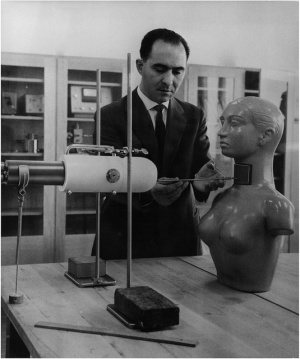Reliability & Validity

IAEA Seibersdorf Historical Images 01210266
There are two fundamental considerations when developing measured variables: reliability and validity.
Reliability refers to the ability to consistently produce a given result. In the context of psychological research, this would mean that any instruments or tools used to collect data do so in consistent, reproducible ways. Unfortunately, being consistent in measurement does not necessarily mean that you have measured something correctly. To illustrate this concept, consider a kitchen scale that would be used to measure the weight of cereal that you eat in the morning. If the scale is not properly calibrated, it may consistently under- or overestimate the amount of cereal that’s being measured. While the scale is highly reliable in producing consistent results (e.g., the same amount of cereal poured onto the scale produces the same reading each time), those results are incorrect. This is where validity comes into play. Validity refers to the extent to which a given instrument or tool accurately measures what it’s supposed to measure. While any valid measure is by necessity reliable, the reverse is not necessarily true. Researchers strive to use instruments that are both highly reliable and valid.
You will soon be introduced to three types of reliability (test-retest reliability, internal consistency, and inter-rater reliability) and four basic kinds of validity (face validity, content validity, criterion validity, and discriminant validity).
Open Textbook Reading Activity
Reliability & Validity
There are two fundamental considerations when developing measured variables: reliability and validity.
Reliability refers to the ability to consistently produce a given result. In the context of psychological research, this would mean that any instruments or tools used to collect data do so in consistent, reproducible ways. Unfortunately, being consistent in measurement does not necessarily mean that you have measured something correctly. To illustrate this concept, consider a kitchen scale that would be used to measure the weight of cereal that you eat in the morning. If the scale is not properly calibrated, it may consistently under- or overestimate the amount of cereal that’s being measured. While the scale is highly reliable in producing consistent results (e.g., the same amount of cereal poured onto the scale produces the same reading each time), those results are incorrect. This is where validity comes into play. Validity refers to the extent to which a given instrument or tool accurately measures what it’s supposed to measure. While any valid measure is by necessity reliable, the reverse is not necessarily true. Researchers strive to use instruments that are both highly reliable and valid.
You will soon be introduced to three types of reliability (test-retest reliability, internal consistency, and inter-rater reliability) and four basic kinds of validity (face validity, content validity, criterion validity, and discriminant validity).
Open Textbook Reading Activity
Read the sections on “Reliability and Validity of Measurement” and “Practical Strategies for Psychological Measurement” in Chapter 5 of your textbook (Psychological Measurement). As you complete this reading, think about which types of reliability and validity are most relevant to your own research question.
Reading Activity
Read the sections on Measurement Validity Types, Types of Reliability, and Reliability and Validity from the Research Methods Knowledge Base
Content is available under the
Creative Commons Attribution Share Alike License.
Privacy Policy | Authors